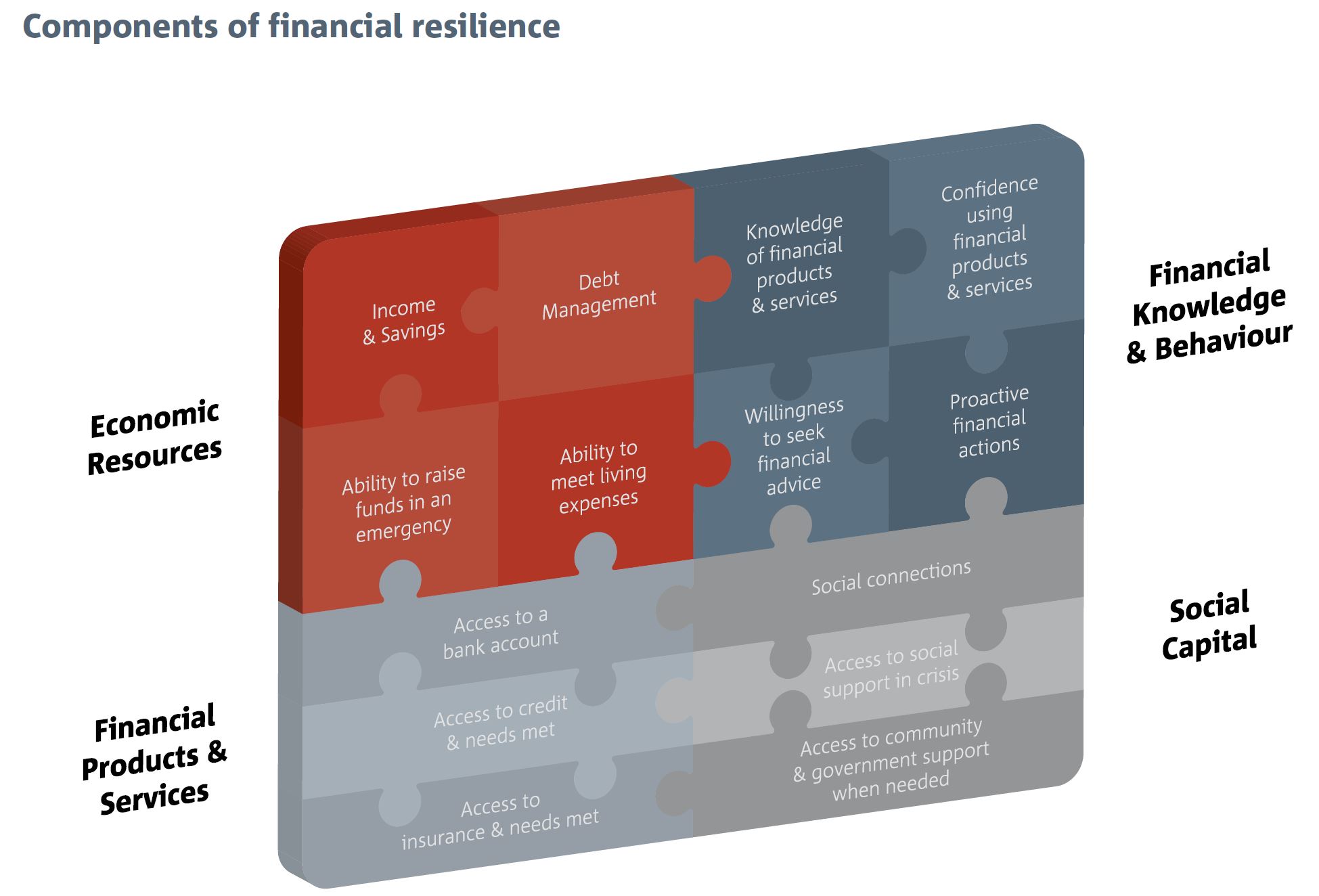A new report released today by the Centre for Social Impact, in partnership with NAB explores the complex reasons why many Australians are facing increasing financial stress. Financial Resilience in Australia 2016 builds on the 2015 report to show that while people are more financially aware, savings are shrinking and economic vulnerability is on the rise.
The overall level of financial resilience in Australia decreased between 2015 to 2016. In 2016, 2.4 million adults were financially vulnerable and there was a significant decrease in the proportion who were financially secure (35.7% to 31.2%).
Looking at the components of financial resilience, between 2015 and 2016: the mean level of economic resources did not significantly change and, in good news, people’s levels of financial knowledge and behaviour significantly increased.
However, people’s levels of access to external resources – financial products and services and social capital – significantly decreased and while savings behaviours were up, the amount of savings people have to rely upon has gone down.
Economic resources: stayed the same overall but there are concerns about savings markers.
- On average, adults in Australia were better able to access funds in an emergency in 2016 (77.6% in 2015 to 81.4% in 2016). But almost 1 in 5 still could not, or did not know if they could raise $2,000 in a week and this rate was worse than findings by the ABS in 2014 (when approximately 1 in 8 were not able to find money in an emergency).
- Of those who reported they could raise $2,000 in an emergency, 70.7% would do so through family or friends demonstrating the importance of social capital.
- While more people were saving in 2016 compared to 2015, less money was being saved relative to people’s income. Almost one in three (31.6%) adults had no savings or were just two pay packets (<1 month of savings) away from serious financial stress if they were to lose their jobs. Like in 2015, almost 1 in 2 reported having less than three months of income saved (46.6 and 45.5% respectively).
Financial products and services: access has gotten worse
- People were more likely to report having no access to any form of credit in 2016 (25.6%) compared to 2015 (20.2%) and no form of insurance (11.8% in 2016 compared to 8.7% in 2015).
- A higher proportion of people reported having access to credit through fringe providers in 2016 (5.4%) compared to 2015 (1.7%).
- There were no differences in the reported level of unmet need for credit overall, between 2015 (3.8%) and 2016 (3.7%). However, 1 in 10 reported having an unmet need for more insurance (10.0% compared to 9.7% in 2015) and an additional 11.6% (compared to 6.4% in 2015) did not know if they needed more insurance.
Financial knowledge and behaviour: has improved
- Adults in Australia reported having a higher level of both understanding of and confidence using financial products and services in 2016 than in 2015. In 2016, 5.5% reported having no confidence using financial products and services and 4.5% reported no understanding at all, compared to 8.2% and 9.2% respectively in 2015.
- There was a positive change in the population’s reported approach to seeking financial advice, with more people reported seeking advice at the time of the survey (7.8% in 2016 compared to 4.8% in 2015).
- More people reported saving regularly in 2016 (60.2%) compared to 2015 (56.4%).
Social capital: has decreased
- Although social capital overall decreased between 2015 and 2016, more people reported having regular contact with their social connections (68% compared to 36.6%).
- A lower proportion of the population reported needing community or government support in 2016.
- However, the proportion of people reporting a need for support but no access to it grew from 3.2% in 2015 to 5.3% in 2016.
Who is doing better? Who is faring worse?
- Income, educational attainment and employment were all positively associated with financial security
- Established home owners were also more likely to be financially secure, while people living in very short-term rentals were more likely to be in severe financial stress.
- Younger people under 35 years of age were less likely than other age groups to experience financial security.
- A higher proportion of people born in a non-English speaking country were in the severe and high financial stress categories, than people born in an English-speaking country, including Australia.
- Mental illness was also negatively correlated to financial security, with a higher proportion of people with a mental illness experiencing severe or high financial stress (44.7% compared to 9.3% of people with no mental illness).
The Centre for Social Impact (CSI) is a national research and education centre dedicated to catalysing social change for a better world. CSI is built on the foundation of three of Australia’s leading universities: UNSW Sydney, The University of Western Australia, and Swinburne University of Technology.


One thought on “More Evidence Of Households In Financial Stress”